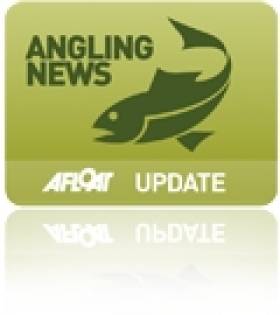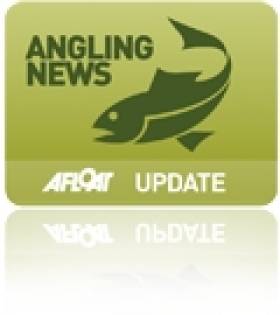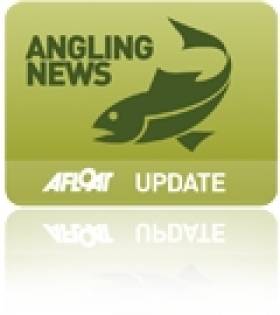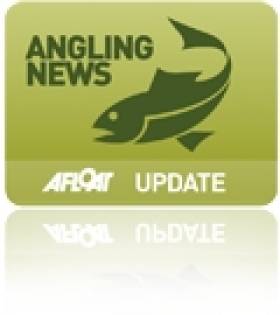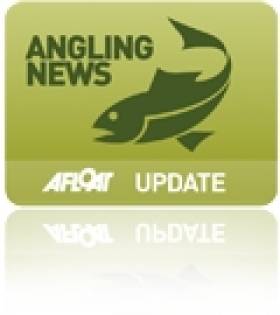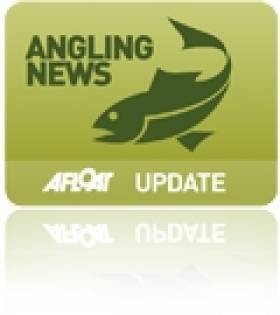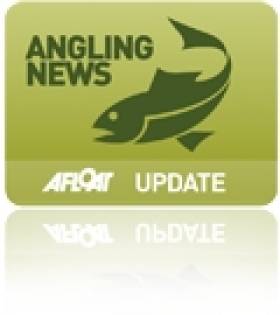Displaying items by tag: Sea Trout
#Angling - Joe McHugh, Minister of State with Special Responsibility for Gaeltacht Affairs and Natural Resources, has announced €230,000 in funding for the rehabilitation of wild Atlantic salmon and sea trout stocks under the Salmon Conservation Fund, managed by Inland Fisheries Ireland (IFI).
Some 24 projects have been approved under the fund, and beneficiaries of this year's scheme include angling clubs, private fishery owners, riparian owners and tourism organisations.
Funds will be distributed across the country with the main beneficiaries undertaking projects on the rivers and tributaries of Castletown, Fane, Dee, Boyne, Vartry, Nore, Suir, Cork Blackwater, Lower Shannon, Newport, Glen and Crana.
The fund was open to contributors to the scheme with works to include: fish passage improvement; spawning enhancement; in-stream structures (such as repairs to weirs, insertion of deflectors, rubble mats, random boulders); river bank protection; fencing to restrict livestock access to the river; and tree pruning, along with the removal and control of exotic invasive species.
These works will contribute towards the rejuvenation of Ireland's wild Atlantic salmon and sea trout stocks with a view to opening further rivers in the coming years to facilitate angling and commercial fishing activities.
The works are seen as an important initiative to conserve, develop and protect the country's valuable natural resources, especially in light of the continued decline of salmon stocks, among other key species, in the Irish Sea.
Minister McHugh commented: "The Salmon Conservation Fund is an annual fund open to contributors to the scheme and I would encourage all those interested in the promotion of our wild Atlantic salmon and sea trout fisheries to consider suitable projects for consideration under the fund for 2015 and beyond."
Full details of the Salmon Conservation Fund can be obtained on the IFI website HERE.
#salmon – Salmon and sea trout from the North Sea will create Yorkshire's most valuable fishery worth at least £12 million a year - in a river barred to them for nearly 40 years.
A barrage on the Derwent river, at Barmby on the Marsh, will be opened eight hours a day from next Saturday (May 24) instead of always being closed. It will allow thousands of salmon and sea trout migrating along the Ouse from the sea to enter the 72-mile river and its tributaries.
It is Yorkshire's biggest river system covering 2,057 square kilometres (794 square miles) and ideal for spawning.
East Yorkshire Rivers Trust masterminded the plan and estimates anglers will now catch 500 salmon and 1,400 sea trout in the river each year.
"That will add £12.5 million to the local economies in Ryedale and districts along the river," said John Shannon, the trust's Derwent restoration project officer.
The barrier was built in the mid 1970s where the river joins the Ouse near Drax power station, to help abstract water. Its boat lock was only opened occasionally so closing off the river to the tidal Ouse and migrating fish.
Mr. Shannon said opening it eight hours a day would safeguard the water supply. Later it was expected to be always open. "With more fish each year there will eventually be ten times more anglers further increasing the benefit to the local economy."
The last time salmon were reported in any numbers in the Derwent was 1976 at Stamford Bridge.
The formal opening of the barrage on Saturday is one of several events in Britain marking World Fish Migration Day.
There will also be an eel stocking when thousands of baby eels will be released. Other fish populations in the river including flounder, lamprey and shad are expected to increase.
At present Yorkshire's most valuable river is the Esk where anglers land 200 salmon and 600 sea trout each year.
East Yorkshire Rivers Trust will be partnered at the event by the Institute of Fisheries Management, the Environment Agency, Natural England and Yorkshire Wildlife Trust.
Space is limited and anyone wishing to attend should e-mail Mr. Shannon at [email protected] to reserve place.
#Angling - The Department of Communications, Energy and Natural Resources has issued new bye-laws for anglers on conservation of salmon and sea trout on three rivers in the West of Ireland.
Bye-law No 917 provides for catch and release in respect of salmon and sea trout over 40cm in length in the Newport River including the waters of Lough Beltra and the Crumpaun River, Co Mayo during the period 20 March to 11 May 2014. More details HERE.
Bye-law No 918 provides for catch and release in respect of salmon and sea trout over 40cm in length in the portion of the Lower Shannon from O’Brien’s Bridge downstream, on the downstream face of the bridge, to Thomond Bridge in Limerick City during the period 1 March to 30 September 2014.
This bye-law also prohibits the use of worms as bait and any fish hooks other than single barbless hooks in angling for salmon and trout in those waters. More details HERE.
And Bye-law No 919 provides for catch and release in angling of salmon and sea trout over 40cm in length in the River Feale, including the Galy and Brick, from 1 March to 11 May 2014, and a bag limit of four fish during the period of 12 May to 30 September subject to a daily limit of one fish during this period.
This bye-Law also prohibits the use of worms as bait and any fish hooks, other than single barbless hooks, in angling for salmon and sea trout over 40cm in length up to 11 May and also from 12 May onwards once the permitted limit had been reached in those waters. More details HERE.
NI Anglers Urged To Review Shrimp Bait Ban Proposals
#Angling - The use of prawns and shrimp as bait in salmon angling could be banned in Northern Ireland under proposed restrictions on salmon and sea trout fishing, as Farming Life reports.
Aside from the bait regulations, Stormont is also putting forward a ban on commercial salmon netting and the introduction of a catch-and-release scheme for sport anglers in an effort to reverse dwindling salmon numbers in Ulster's inland waterways.
The moves come following an earlier voluntary ban on offshore salmon fishing in an effort to bolster wild salmon stocks which were last year feared to be "around dodo levels".
Similar restrictions were proposed this year for the River Suir - although anglers in Enniscorthy won support from Inland Fisheries Ireland last year in their call to lift a shrimp bait ban on their downstream fishery on the River Slaney.
Ulster Angling Federation chair Jim Haughey has urged angling club officials across Northern Ireland to study the consultation document published by the Department of Culture, Arts and Leisure with a view to making informed submissions on the proposed changes.
Farming Life has much more on the story HERE.
Draft Net Season Won't Be Brought Forward Says Minister
#ANGLING - Minister for Natural Resources Fergus O’Dowd has confirmed that there is no proposal for the extension of the salmon draft netting season.
In response to concerns expressed by the angling community and highlighted by Derek Evans in The Irish Times last week, Minister O’Dowd emphasised that conservation and management of salmon and sea trout is key to protecting our valuable natural resources.
“Recent reports that the commercial season will be extended in certain rivers are untrue and I can confirm that for the 2012 season, the commercial fishing season remains as it was in all areas, with the River Suir still on a reduced season for snap fishing," said the minister.
"I am aware that confusion can arise due to the necessary extent of regulations in place. However, I am not considering any proposal for the extension of the commercial season."
The minister reminded that Inland Fisheries Ireland is the body that enforces Ireland's "extensive" fisheries legislation.
"IFI has offices throughout the country where advice can be sought. There is also a comprehensive and regularly updated website and information is also disseminated on Facebook and Twitter," he said.
Meanwhile, IFI chief executive Dr Ciaran Byrne said that the legislative code is regularly updated to ensure that Ireland's fisheries continue to be protected on the basis of information from IFI’s Standing Scientific Committee and IFI management advice.
“Only rivers with exploitable surpluses are open during the spring season and no fishery is open for commercial exploitation during this time," said Dr Byrne. "Fisheries that are classified catch-and-release or closed for salmon are now protected under bye-law 897 which prohibits the use of worms and the use of any fish hooks other than single barbless hooks.
"IFI’s priorities are maximising the return to Ireland, protecting sustainable jobs in isolated rural communities and promoting our wonderful angling resources," he added.
Survey to Assess Value of Irish Angling
#ANGLING - Inland Fisheries Ireland (IFI) has appointed Tourism Development International (TDI) to undertake a Socio-Economic Survey of Recreational Angling in Ireland.
The overall objective of the survey, which will run over the course of 2012, is to establish the current volume and value of domestic and overseas recreational angling in the country.
Pike, coarse fish, bass, salmon, sea trout, brown trout and sea anglers will all be invited to participate in what is described as Ireland's most comprehensive angling survey undertaken in decades.
The survey will inform IFI and its tourism partners in relation to the business of angling in Ireland and also enable improved strategic planning and decision-making in terms of product development and marketing.
"Anglers are the key to this survey," commented Minister of State for Natural Resources Fergus O'Dowd. "They know the resource and they understand the importance of sustainability. What anglers contribute to Ireland’s economy is unknown but I am certain that it is significant.
"Angling takes place in every river and lake in Ireland and all around our coastline. There is no town or village in Ireland that doesn’t have anglers."
He added: "It is imperative that the inland fisheries and sea angling resources are managed in the best way possible to ensure enjoyment for our local and visiting anglers, sustainable jobs in rural communities and maximising its potential to add to Ireland’s economy.
"Getting the right information from those most involved will greatly assist in improving the angling product."
The survey comprises two parts: a household survey and a survey of recreational anglers which will commence in April. Anglers will be met at fishing locations throughout Ireland and invited to participate there and then, or later by phone or online. IFI says that every effort will be made to accommodate participation.
- angling
- Inland Fisheries Ireland
- IFI
- Tourism Development International
- TDI
- survey
- SocioEconomic Survey of Recreational Angling in Ireland
- Pike
- Salmon
- Sea Trout
- brown trout
- coarse angling
- sea angling
- tourism
- business
- marketing
- development
- Minister of State for Natural Resources
- Fergus O'Dowd
- sustainability
- inland waterways
- jobs
#ANGLING - The 30-day public consultation on new regulations for the management of the 2012 wild salmon and sea trout fishery will expire next Thursday, The Irish Times reports.
The new regulations are based on advice from Inland Fisheries Ireland following an assessment of 141 rivers nationwide by the Salmon Standing Scientific Committee.
That assessment recommended that that 43 rivers should open (seven fewer than in 2011); 34 rivers should open for catch-and-release (six more than 2011); and 64 rivers should be closed (one fewer than 2011).
New conservation rules include bag limit for sea trout and a restriction on angling for other species when fishing for salmon on closed rivers.
The Irish Times has more on the story HERE.
Bumper Catch at Rock House Fishery
Described by The Irish Times' Derek Evans as "one of the Great Fishing Houses of Ireland", the Rock House fishery in Co Mayo boasted banner numbers of salmon and sea trout catches this spring and summer.
April started off strong on the Owenduff River in Ballycroy, with three spring salmon weighing between 9.5lb and 12lb landed in the first two weeks.
This was followed by respectable numbers in May of 30 salmon and three sea trout. But June and July were the bumper time for angling, with thundery rain aiding the catch.
Even August proved bountiful despite lacking in fresh grilse, with 12 salmon ad 27 sea trout caught throughout the month.
"Drift netting laws appear to be having a positive effect," said Rock House's Sibylle Geffroy.
The Irish Times has more on the story HERE.
Public Consultation on the Wild Salmon and Sea Trout Tagging Scheme Regulations for 2011 Season
The Minister for Natural Resources, Conor Lenihan, has announced the start of a 30 day public consultation process on the Wild Salmon and Sea Trout Tagging Scheme Regulations for the 2011 season.
Regulations are made each year, after public consultation, for the management of the wild salmon and sea trout fishery, based on the scientific and management advice provided to the Minister by Inland Fisheries Ireland.
In launching the public consultation process the Minister remarked,
"The 2011 season will see 20 rivers which were closed in 2010 being opened because of an improvement in salmon stocks. Nineteen rivers will be open to angling on a 'catch & release' basis and 4 rivers which were previously closed, Castletown, Suir, Glenamoy and Eske will open with an identified surplus number of fish for harvest."
In all the Salmon Standing Scientific Committee assessed 141 rivers and have advised that:-
· 51 rivers are open (a surplus of fish has been identified in these rivers) i.e. 1 more than in 2010
· 30 rivers have been classified as open for "Catch and Release" only i.e. 19 more than 2010 (see list below) and
· 60 rivers are closed (no surplus of fish available for harvest) i.e. 20 less than 2010.
With the exception of a proposed change to the number of blue (angling) tags applicable to a one day salmon licence holder, the draft Tagging Scheme Regulations for 2011 are in essence unchanged from the Regulations which were introduced following the establishment of Inland Fisheries Ireland in July, 2010.
A number of minor amendments to the Regulations have also been recommended by Inland Fisheries Ireland, which will provide for more effective administration of the tagging scheme regulations in 2011.
Summary of main changes to the management of the wild salmon fishery in 201120 Rivers which were closed in 2010 will open for angling on a "catch & release" basis in 2011:-
Glyde (Dundalk fishery district)
Slaney (Wexford fishery district) (note; river is closed until 12 May 2011)
Bride (Lismore fishery district)
Glengariff, Adrigole (Cork fishery district)
Kealincha, Lough Fada, Blackwater, Behy, Owenascaul, Milltown, Feohanagh
(Kerry fishery district)
Grange (Sligo fishery district)
Oily, Owenwee (yellow river) (Ballyshannon fishery district|)
Bracky, Glenna, Tullaghobegley, Ray, Glenagannon (Letterkenny fishery district).
4 Rivers which were "catch & release" in 2010 and will open for harvest in 2011 Castletown (Dundalk fishery district)
Suir (Waterford fishery district)
Glenamoy (Bangor fishery district)
Eske (Ballyshannon fishery district).
3 Rivers which were open in 2010 will be limited to "catch & release" in 2011
Sheen (Kerry fishery district)
Screebe (Connemara fishery district)
Srahmore (Bangor fishery district).
The Minister is giving statutory notice of his intention to make the Wild Salmon and Sea Trout Tagging Scheme (No. 2) Regulations, 2010 to provide for the management of the wild salmon and sea trout fishery by Inland Fisheries Ireland in 2011 following the 30 day public consultation.
Any person may submit objections to the draft regulations at any time during the period of 30 days commencing on 20 November 2010 either in writing to the Department or by e-mail to [email protected]
Details of the conservation proposals for 2011 and the draft regulations are available on the Department's website http://www.dcenr.gov.ie/Natural/Inland+Fisheries+Division/Consultation+Process+Wild+Salmon+and+Sea+Trout+Tagging+Scheme+Regulations+for+2011+fishing+season.htm
Minister Lenihan launches €2million Celtic Sea Trout Project
The Celtic Sea Trout Project has its official launch at Coillte's Avondale House, Rathdrum, Co. Wicklow this evening. This groundbreaking €2million project, mainly funded by the Wales – Ireland Interreg programme, will see Inland Fisheries Ireland work closely with anglers, fishery owners, netsmen, inshore and offshore marine fishermen and in cooperation across the 6 political and administrative regions with separate jurisdictions over the Irish Sea with the ultimate goal of ensuring sustainable sea trout fisheries.
Sea trout support and sustain important and valuable fisheries throughout the study area and are a unique and potentially valuable indicator of environmental change and the quality of the aquatic environment. The overall project aims are to further the proactive conservation of trout biodiversity and to enable better management of sea trout stocks in their freshwater and marine environments so as to strengthen their social, economic and cultural benefits to local and regional communities. It also aims to promote cooperative working, the effective dissemination of knowledge and a wider general awareness of management needs and options for the conservation and sustainable management of sea trout stocks.
Launching the project Minister Conor Lenihan commented that "the Celtic Sea Trout project represents a major step forward to achieving our ultimate goal of maintaining healthy fish stocks that support biodiversity, sustainable fisheries and provide optimum benefits for the general community as a whole".
For further information on the Celtic Sea Trout Project please log on to www.celticseatrout.com


























